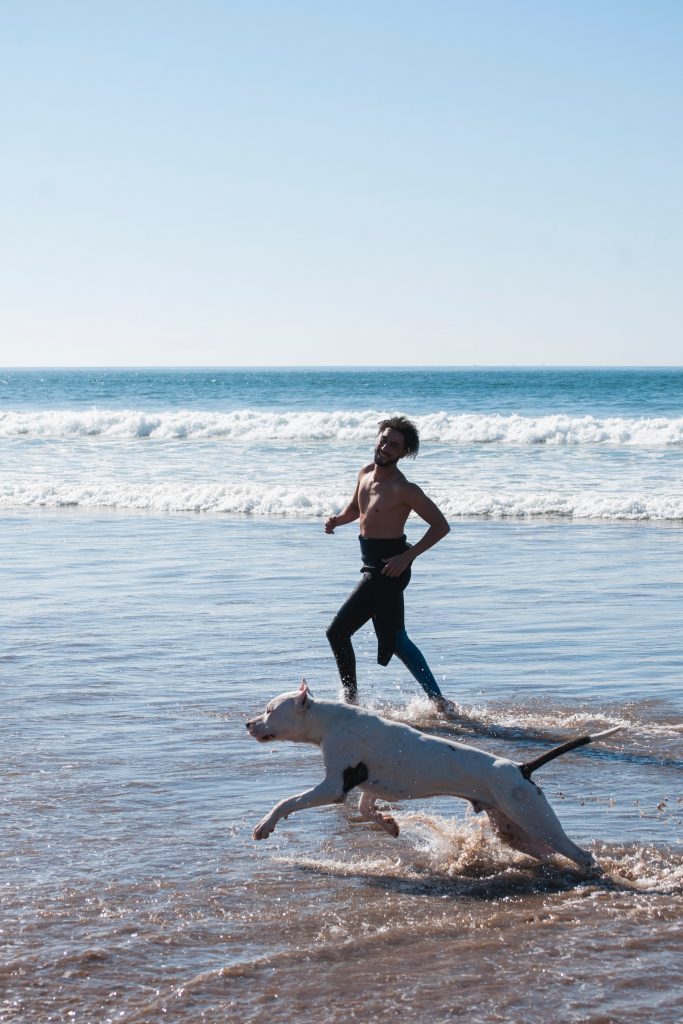Already almost the end of January of the New Year. Hard to believe isn’t it!
Did you make a New Year Resolution and are you keeping to it? Making a New Year Resolution and sticking to it is much easier if you involve your dog…after all, they need to keep fit and lose weight too! Why not try to exercise together?
Safety First! Before you start exercising with your best friend, consider a few safety tips first…
- Ensure there are no medical reasons not to exercise- for either of you! If your pooch is just recovering from an operation, has bone or joint disease, is very young or old or is in heart failure, increasing exercise may not be a good idea. Check with your vet if you aren’t sure.
- Ensure that you do not exercise immediately after eating- we recommend waiting at least four hours after feeding your dog or eating yourself before undertaking any exercise.
- Don’t forget to load up with water for both of you before you go, and don’t exercise in the heat.
So here they are- our top five New Year exercises to do with your dog.
Running
This may seem like an obvious one, but running with your dog is an excellent way for you both to get some exercise. However, start with shorter runs and build up slowly so that you both have time to adapt to the new regime- there are apps to help with this. Also, you can make it more interesting by alternating running with walking- your pooch will quickly learn to pay attention to your signals to speed up or slow down, ensuring a workout for his mind as well as his body. Too easy? Try taking on a muddy obstacle course together- our shampoos are perfect for washing down after a good muddy run.

Cycling
Yes, you can cycle with your dog! Some mountain bikers will take their dogs with them and let them run loose ahead of the bike, which is fine as long as the path is safe, not near a road, and your dog is friendly. For those places where you can’t go leadless, there are bike leads available. These clip onto your bike seat so that you can use both hands for cycling. And for those dogs that just can’t keep up, you can get trailers and seats for your bike so that you don’t have to leave them behind!
Swimming
Swimming is excellent exercise for both of you, and has the advantage of being kind to joints. There are canine hydrotherapy pools all over the country, but if you want to swim together then dog-friendly beaches are the way to go. However, do follow any local advice given and never go out of your depth. Canine buoyancy aids are available and have handles so you can easily retrieve your pet from the water if they run into difficulty. Don’t forget to dry them off thoroughly afterwards!
Agility
Although most people think of agility as being only a sport for the dogs, most owners will tell you that this sport also has them running. Many societies will welcome beginners and love to teach the sport to newcomers, so look for a club local to you.
Yoga
AKA ‘Doga’, a yoga class you can attend with your dog. Although the exercise your dog will be doing is minimal, it’s great opportunity for the two of you to bond and is great for older pets. All of the holds and lifts have been designed to be safe and relaxing whilst giving you some quality time together. It’s best to find an instructor in order to ensure you get the most from your experience.
What about weight loss resolutions?
With over 60% of UK dogs classed as overweight, the chances are high that your dog needs to lose a little (or a lot!) to have a longer, healthier life. Obesity is classed as one of the leading animal welfare issues in the developed world- it causes diabetes, skin conditions, behavioural problems, and joint disease such as arthritis, and is even related to higher incidence of certain cancers. If you make just one New Year’s Resolution this year, make it to help your dog lose weight.
Whilst the exercise tips above will help your dog to lose weight, just as with us, fewer calories is the key to kick-starting the weight loss. Don’t just take away some of your dog’s food and expect it all to go smoothly, however- they’re masters at begging and making us feel bad, so we’ve got some top tips below.
Get Help
Talk to your veterinary team. Most practices offer a free nurse weight loss clinic. Just as with humans going to Weight Watchers classes, having regular weigh-ins with your nurse keeps you on track and gives you someone to complain to when it’s not all going to plan! Nurses can calculate calorie allowances for safe weight loss and are experts at spotting when there’s a medical reason that the weight loss isn’t going to plan.
Slow Feeders
Slow down their eating and make them work for their food. This could mean using a food dispensing toy, a slow feeder bowl, or even just scattering their biscuits around the house or garden. Instead of eating the food in three big gulps and then begging for more they’ll be distracted for ages!
Prescription Weight Loss Diets
Consider a prescription weight loss diet. For the greedy dogs out there, these diets contain fewer calories in more biscuits, so the bowl doesn’t look so empty. The added fibre also helps dogs to feel fuller for longer, stopping the begging of treats. In addition, they’re packed with vitamins and minerals- one of the concerns about decreasing the amount of a ‘normal’ food to reduce calories is that you’re also reducing the vitamin and mineral intake, but these foods are especially designed to stop this from happening.
Stop the Treats
Take the calories in treats into account. That’s not just the treats for dogs you buy at the pet shop, that’s all the calories they take in. The crust of bread from the toddler, the dental chew in the afternoon, and the milk bone before bed. It’s really important to get the whole family on board- it’s amazing how often the dog gets fed twice or a relative is feeding tidbits from the table, undoing all your hard work!
Weigh it Out
Weigh out your dog’s food. Most people take the weight of kibble from the back of the packet and translate it into a volume- such as ‘half of this mug’ or ‘a handful and a half’. Unfortunately, depending how the kibble settles in the cup this can cause a difference of 10%. So, if your dog should be getting 540 calories, he could actually be getting 600- a big difference for a little dog! Set aside 10 minutes on a Monday evening to weigh out all the food for the week into labelled bags- that way there’s no double-feeding and you’re sure they’re getting the right number of calories!
Whatever you resolve to do this New Year, we hope you all have a fantastic 2020!

